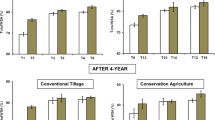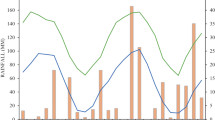Abstract
A field study was conducted during 2009–2011 to investigate the effect of tillage, crop establishment and residue management practices on soil and root parameters in soybean-wheat cropping system. The experiment was conducted with 4 main plot treatments of tillage and crop establishment techniques as conventional tillage-flat (CT-F), zero tillage-flat (ZT-F), conventional tillage-bed (CT-B) and zero tillage-bed (ZT-B); and 4 sub plot treatments of residue application as control, wheat residue (3 t ha−1), soybean residue (3 t ha−1) and soybean + wheat residue (3 t ha−1 each). The infiltration rate was significantly higher with ZT-F (1.22 cm h−1) and wheat + soybean residue application (1.16 cm h−1). ZT-F and ZT-B recorded higher mean weight diameter and geometric mean diameter at 0–10 cm than that of CT-F and CT-B. The percentage of micro-aggregate was higher with CT-F and CT-B at all depths while the macro-aggregate was high with ZT-F and ZT-B up to 30 cm soil depth. The microbial biomass carbon in ZT-F and ZT-B was 216.3 and 214.6 µg g−1 of soil, respectively which was significantly higher than that of CT-F and CT-B. The wheat + soybean residue application recorded 19.6 % higher MBC than the control. Among the tillage treatments, ZT-F performed well with regard to root length density as 2.38 and 1.11 cm cm−3, root surface area as 0.67 and 0.36 cm2 cm−3, root volume density as 19.22 and 8.26 × 10−3 cm3 cm−3 and average root diameter as 1.06 and 0.81 mm by soybean and wheat, respectively. Similarly, wheat + soybean residue also performed better than the no residue treatment.
Similar content being viewed by others
References
Hobbs P, Sayre K, Gupta R (2008) The role of conservation agriculture in sustainable agriculture. Phil Trans R Soc B 363:543–555
Fowler R, Rockstrom J (2001) Conservation tillage for sustainable agriculture—an agrarian revolution gathers momentum in Africa. Soil Tillage Res 61:93–107
Husnjak S, Filipovic D, Kosutic S (2002) Influence of different tillage systems on soil physical properties and crop yield. RostlinnaVyroba 48(6):249–254
Box JE, Ramseur EL (1993) Minirhizotron wheat root data: comparisons to soil core root data. Agron J 85:1058–1060
Aggarwal P, Goswami B (2003) Bed planting system for increasing water use efficiency of wheat grown on inceptisol. Ind J Agric Sci 73:422–425
Lupwayi NZ, Arshad MA, Rice WA, Clayton GW (2001) Bacterial diversity in water-stable aggregates of soils under conventional and zero tillage management. Appl Soil Ecol 16:251–261
Prasad R, Shivay YS, Kumar D, Sharma SN (2006) Learning by doing exercise in soil fertility (a practical manual for soil fertility). Division of Agronomy, Indian Agricultural Research Institute, New Delhi, p 68
Piper CS (1950) Soil and plant analysis. The University of Adelaide, Australia, pp 286–287
Chopra SL, Kanwar JS (1991) Analytical agriculture chemistry. Kalyani Publishers, New Delhi
Bouwer H (1986) Intake rate cylinder infiltrometer. In: Klute A (ed) Method of soil analysis, part 1. ASA Agronomy Monograph, Madison, pp 825–843
Kemper WD, Rosenau RC (1986) Aggregate stability and size distribution. In: Klute A, Campbell GS, Jackson RD, Mortland MM, Nielsen (eds) Methods of soil analysis. Part I. Physical and mineralogical methods, 2nd edn. American Society of Agronomy-Soil Science Society of America, Madison, pp 425–442
Oades JM, Waters SAG (1991) Aggregate hierarchy in soils. Aust J Soil Res 29:815–828
Walkley AJ, Black CA (1934) Estimation of soil organic carbon by the chronic acid titration method. Soil Sci 37:29–38
Subbiah BV, Asija GL (1956) A rapid procedure for the estimation of available nitrogen in soils. Curr Sci 25(8):259–260
Olsen BC, Cole CV, Watenabe FS, Dean LA (1954) Estimation of available phosphorus by extraction with sodium carbonate. USDA circ. no. 939, p 19
Jackson ML (1973) Soil chemical analysis, II edn. Prentice Hall of India Pvt. Ltd, New Delhi, p 498
Vance ED, Brookes PC, Jenkinson DS (1987) An extraction method for measuring soil biomass carbon. Soil Biol Biochem 19:703–707
Aggarwal P, Sharma NK (2002) Water uptake and yield of rainfed wheat in relation to tillage and mulch. Indian J Soil Conserv 30(2):155–160
Arsenault JL, Poulcur S, Messier C, Guay R (1995) WinRHIZO™, a root-measuring system with a unique overlap correction method. HortSci 30(4):906
Guay R, Arseneault JL (1996) Win/MacRhizo root overlap compensation method. Internal Technical Note, vol. 4. Regent Instruments Inc
Azooz RH, Arshad MA, Franzluebbers AJ (1996) Pore size distribution and hydraulic conductivity affected by tillage in Northwestern Canada. Soil Sci Soc Am J 60:1197–1201
Obalum SE, Obi ME (2010) Physical properties of a sandy loam Ultisol as affected by tillage-mulch management practices and cropping systems. Soil Tillage Res 108:30–36
Buschiazzo DE, Panigatti JL, Unger PW (1998) Tillage effects on soil properties and crop production in the sub-humid and semi-arid Argentinean Pampas. Soil Tillage Res 49:105–116
Bhattacharyya R, Prakash V, Kundu S, Gupta HS (2006) Effect of tillage and crop rotations on pore size distribution and soil hydraulic conductivity in sandy clay loam soil of the Indian Himalayas. Soil Tillage Res 82:129–140
Shaver TM, Petrson GA, Ahuja LR, Westfall DG, Sherrod LA, Dunn G (2002) Surface soil physical properties after twelve years of dry land no-till management. Soil Sci Soc Am J 66:1296–1303
Acharya CL, Sood MC (1992) Effect of tillage methods on soil physical properties and water expense of rice on an acidic Alfisol. J Indian Soc Soil Sci 40:409–414
Wright AL, Hons PM (2005) Tillage on soil aggregation and carbon and nitrogen sequestration under wheat cropping sequences. Soil Tillage Res 84:67–75
Six J, Elliott ET, Paustian K (2000) Soil macroaggregate turnover and microaggregate formation: a mechanism for C sequestration under no-tillage agriculture. Soil Biol Biochem 2:2099–2103
Mahboubi AA, Lal R (1998) Long-term tillage effects on changes in structural properties of two soils in central Ohio. Soil Tillage Res 45:107–118
Whalen JK, Hu Q, Liu A (2003) Compost applications increase water-stable aggregates in conventional and no-tillage systems. Soil Sci Soc Am J 67:1842–1847
Verhulst N, Deckers J, Govaerts B (2009) Classification of the soil at CIMMYT’s experimental station in the Yaqui Valley near Ciudad Obregón, Sonora, Mexico. CIMMYT report. CIMMYT, Mexico
Stockdale EA, Brookes PC (2006) Detection and quantification of the soil microbial biomass: impacts on the management of agricultural soils. J Agric Sci Camb 144:285–302
Sarkar R, Kar S (2011) Temporal changes in fertility and physical properties of soil under contrasting tillage-crop residue management for sustainable rice-wheat system on sandy-loam soil. J Crop Improv 25(3):262–290
Sarkar R, Kar S (2008) Sequence analysis of DSSAT to select optimum strategy of crop residue and nitrogen for sustainable rice–wheat rotation. Agron J 100(1):87–97
Malhi SS, Nyborg M, Goddard T, Puurveen D (2011) Long-term tillage, straw and N rate effects on some chemical properties in two contrasting soil types in Western Canada. Nut Cycl Agroecol 90:133–146
Stoffel S, Gutser R, Claassen N (1995) Root growth in an develop agricultural landscape of the “Tertiar-Hugelland”. Agribiol Res 48:330–340
Gerard CJ, Sexton P, Shaw G (1982) Physical factors influencing soil strength and root growth. Agron J 74:875–879
De Freitas PL, Zobel RW, Snyder VA (1999) Corn root growth in soil columns with artificially constructed aggregates. Crop Sci 39:725–730
Chassot A, Richner W (2002) Root characteristics and phosphorus uptake of maize seedlings in a bilayered soil. Agron J 94:114–127
Author information
Authors and Affiliations
Corresponding author
Rights and permissions
About this article
Cite this article
Karunakaran, V., Behera, U.K. Effects of Tillage and Residue Management Practices on Soil and Root Parameters in Soybean (Glycine max)–Wheat (Triticum aestivum) Cropping System. Proc. Natl. Acad. Sci., India, Sect. B Biol. Sci. 88, 487–496 (2018). https://doi.org/10.1007/s40011-016-0777-0
Received:
Revised:
Accepted:
Published:
Issue Date:
DOI: https://doi.org/10.1007/s40011-016-0777-0




